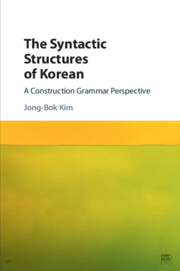Book contents
- Frontmatter
- Contents
- Acknowledgments
- Abbreviations
- 1 Theoretical foundations
- 2 Noun phrases
- 3 Case system
- 4 Auxiliary and complex predicate constructions
- 5 Gerund phrases and mixed categories
- 6 Verbal nouns and light verb constructions
- 7 Serial verb constructions
- 8 Negation and related phenomena
- 9 Coordination
- 10 Passive constructions
- 11 Wh-questions
- 12 Topic and focus constructions
- 13 Relative clause constructions
- 14 Honorification
- References
- Index
2 - Noun phrases
Published online by Cambridge University Press: 05 July 2016
- Frontmatter
- Contents
- Acknowledgments
- Abbreviations
- 1 Theoretical foundations
- 2 Noun phrases
- 3 Case system
- 4 Auxiliary and complex predicate constructions
- 5 Gerund phrases and mixed categories
- 6 Verbal nouns and light verb constructions
- 7 Serial verb constructions
- 8 Negation and related phenomena
- 9 Coordination
- 10 Passive constructions
- 11 Wh-questions
- 12 Topic and focus constructions
- 13 Relative clause constructions
- 14 Honorification
- References
- Index
Summary
In Korean, the ordering of NP constituents is known to be quite flexible, but few attempts have been made to provide their precise syntactic structures. This chapter reviews the distributional properties of Korean prenominal expressions as well as relevant ordering constraints, and then offers a surface-oriented analysis of Korean NP structures. This surface-oriented, construction-based analysis, tightly interacting with lexical information, can not only capture the flexible orderings of prenominal expressions in a simple manner but also generate proper and precise NP structures.
Basic properties
It is well known that prenominal expressions in Korean display a high flexibility in their distributional possibilities. For example, the prenominal expression chakha-n ‘good-natured’ can either precede or follow a determiner:
(1) a. ku chakha-n haksayng
the good.natured-MOD student
‘the good-natured student’
b. chakha-n ku haksayng
good.natured-MOD the student
‘the good-natured student’
The prenominal expressions in Korean can be largely classified into two types: deterministic and phrasal. The deterministic prenominals, which we call (lexical) determinants here, roughly correspond to determiners in English (cf. Jackendoff 1977, Huddleston and Pullum 2002 for English).
The lexical determinants have been traditionally classified into five types in accordance with their semantic contribution (see Nam and Ko 1993, Chang 1996, Sohn 1999).
(2) a. characteristic: say ‘new’, hen ‘old’, yeys ‘old’, ttan ‘other’, …
b. indicative: i ‘this’, ku ‘the’, ce ‘that’, …
c. interrogative: enu ‘which’, mwusun ‘what’, etten ‘which’, …
d. quantificational: motun ‘all’, myech ‘some’, yele ‘several’, …
e. numeral: han ‘one’, twu ‘two’, sey ‘three’, …
These lexical determinants combine with a nominal head, forming an NP structure.
Different from these lexical determinants, there are also phrasal prenominal expressions such as adjectival elements, relative clauses, and genitive-marked possessive NPs:
(3) a. Adjectival:
acwu [khu-ko] [pissa-n] [ppalka-n] chayk
very big-and expensive-MOD red-MOD book
‘a very big and expensive red book’
b. Relative:
[Mia-ka ilk-un] ku chayk
Mia-NOM read-MOD the book
‘the book that Mia read’
c. Genitive:
[Mia-uy] ku chayk
Mia-GEN the book
‘Mia's book’
These prenominal expressions are marked with the MOD suffix (-(u)n in (3a) and (3b)) or the GEN marker (uy in (3c)) and then combine with the following nominal head.
- Type
- Chapter
- Information
- The Syntactic Structures of KoreanA Construction Grammar Perspective, pp. 26 - 46Publisher: Cambridge University PressPrint publication year: 2016



